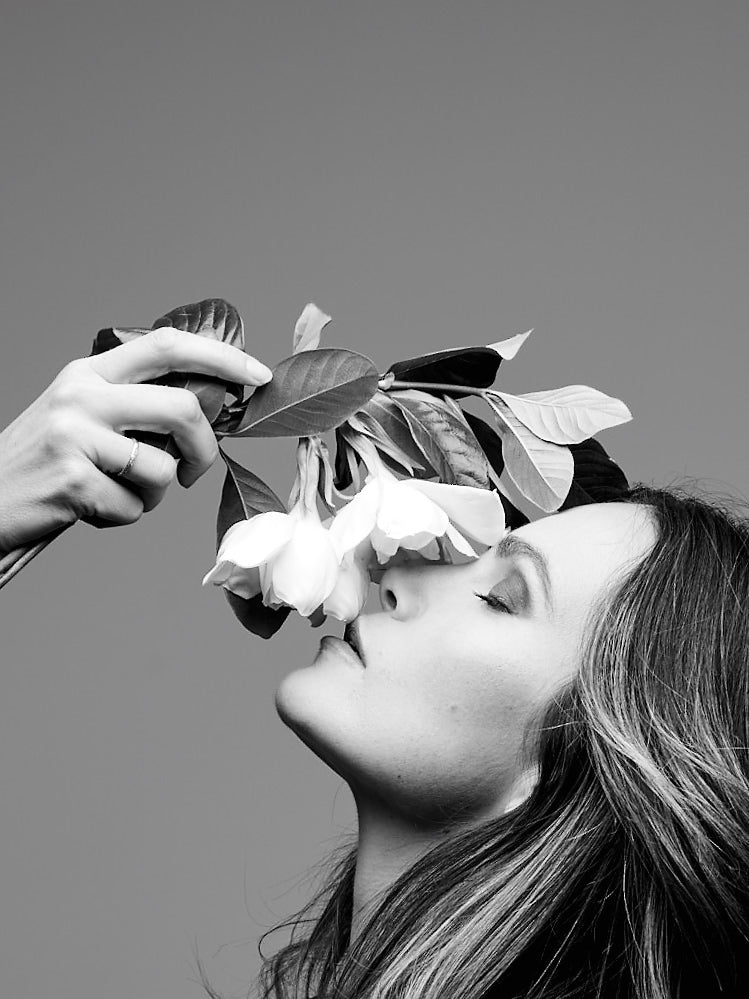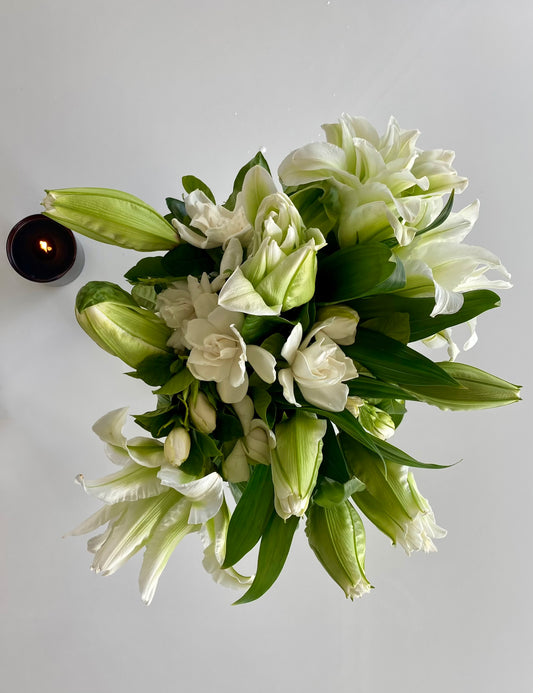A Gardenia Care Guide
As the sole purveyor of the most coveted blooms available, High Camp proudly delivers fresh gardenias cut-to-order, overnight to your door. Enjoy our blooms anywhere in the 48 Continental States, Hawaii and Canada, shipped directly from our farms on the California coast.
Gardenias are notoriously fragile flowers that require special care to prolong their vase life. We would love to provide you with some tips on how best to care for these rare, exquisite blooms. A little TLC goes a long way in extending the freshness and fragrance of fresh-cut gardenias. We hope to inspire you to express your personal style in the art of custom arrangement.
Gardenia Care 101
HIGH CAMP GARDENIAS are grown with love and packaged with care in premium, glossy, water-resistant gift boxes to minimize exposure to light and air. They’re shipped via FedEx priority overnight from our California farms to your home for ultimate freshness. Given the limited bloom time for gardenias, we only cut our flowers once ordered. Our goal is to guarantee freshness and radiance for as long as possible.
It is thought that gardenias should not be cared for by hand. In fact, many florists will only prepare their plants while gloved. This is because the oils in our skin react with the delicate petals and change their color. Contrary to common practice, you may care for our flowers bare-handed. Because our gardenias are so fresh, it is okay to touch the petals if your hands are clean and damp and the petals have been run under water.
Less fresh gardenias from other vendors may become yellow after being touched, which will ruin their pristine white appearance. High Camp gardenia flowers are always of the utmost freshness - so you can enjoy them for days to come.
It is normal for gardenias to arrive a bit sleepy and thirsty. To waken and prepare them for your enjoyment, simply snap the tips (like asparagus) and place stems in cool water. You might also create a small cut length-wise using a clean, sharp knife or scissors along the stem of the plant. This ensures maximum water absorption – exactly what gardenias need for a longer, fresher vase life.
Because a gardenia's lifespan is approximately three days, you may consider saving a few blooms in a plastic bag with a wet paper towel in the refrigerator to freshen your arrangements a couple of days in. Gardenias love moisture and the protection from the bag safeguards the flowers from harmful ethylene gas produced by ripening fruit. This also applies to countertop gardenias. While beautifying your kitchen with our elegant gardenias, keep in mind that they shouldn’t be placed near fresh fruit, as it accelerates the wilting process.
Another way to prolong freshly cut plant life is to keep their vases and bowls as clean as possible. Bacteria and debris multiply quickly if left unattended. Remove all submerged leaves when attending to your blooms. When transferring vases, clean the new vase prior to introducing your new plant.
Gardenias are nature's most fragrant flowers. Enjoy your plants in any setting, from casual to elegant, and as often as possible. Once you’ve experienced their unrivaled aroma, you will wonder how you ever lived without them!
Loose Blooms
Loose blooms arrive without leaves or stems and are lovely en masse in bowls and other vessels. Simply place them face up into 1-2 inches of water. The blooms will open within a few hours and last for 3-4 days, providing continuous fragrance and glorious white, velvety petals. Enjoy the beauty of the blooms in one large grouping with room to bloom, or divide them among smaller vessels to spread around your home. They make beautiful table accents between plates, candles, or even as a fragrant centerpeice.
Vines
Vine gardenias arrive on 8-10 inch stems with tight blooms that blossom over 2-3 days. “Vine gardenias” should be placed in cool water in a clean vessel or vase. Snap tips (like asparagus) for the best water absorption and trim leaves that would otherwise be submerged. Within a few hours, the luscious white flowers will brighten every room in your home.
How to Combat Bud Drop
Gardenias are delicate little beauties, and they must be treated with care. Bud drop is when a plant’s buds or blooms fall off prematurely. With gardenias, this is often caused by improper watering, harsh handling, or vase placement.
Be mindful of the water level in your container. Inadequate watering will result in bud droppage as the plants attempt to preserve their moisture. We recommend keeping your flowers moist at all times. Gardenias also prefer natural light. However, your freshly cut plants don’t require nearly as much direct sun as in their normal, sunny growing environment. You may consider placing them in a room that receives a few hours of sunlight and shade in the afternoon. Too much sun will dry them out prematurely.
Useful Tips: How to Care for Fresh Cut Gardenias
- Trimming
- Prune the stem ends every other day (less than 1 inch at a time) to keep the arrangements clean and absorbent.
- Remove wilting or dry sections to save nutrients for the thriving flowers and glossy leaves.
- Flower Food
- You may already be aware that freshly cut flowers will benefit from nutrients being added to their water. Just like us, flowers require the proper food, water, and shelter in order to thrive. Here are a few flower food options for you:
- Combine 1 quart of water, one tablespoon of sugar, and ½ teaspoon of bleach and stir well. The water and sugar provide nutrients, while the bleach wards off harmful bacteria.
- Mix one part lemon lime soda with three parts water. The sugar in the soda helps to nourish the flowers.
- Use ready-made flower food, and be sure to follow the instructions on the packet.
- Water
- Changing the vase water every 2-3 days keeps the stems in a clean environment, free from germs and unnecessary bacteria.
- Use lukewarm water (approximately 100 degrees ℉) so as not to shock the plant’s environment.
Now that you know how to care for gardenias, take a moment to browse our selection of fresh flower centerpieces. We also offer a range of other luxury gifts, including candles, vines, vases, and loose-leaf blooms.





